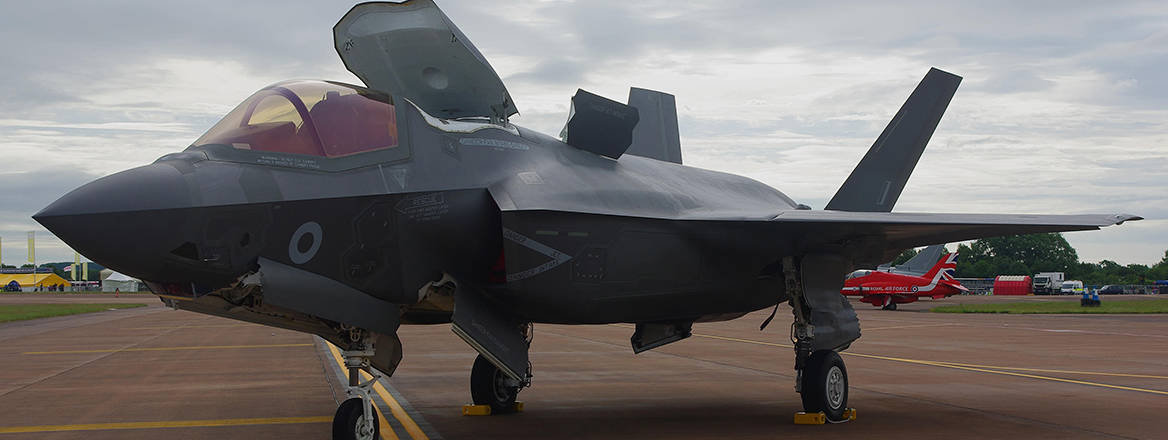An RAF F-35B, stranded at an airport in Kerala province for several weeks, casts a pall over the image of the UK's air combat power in the midst of Highmast, an operation intended to declare full operational capacity for the fleet.
Images and AI-generated renditions of a stranded Royal Air Force (RAF) F-35B jet in India have recently been shared by multiple media outlets and on social media. One of the first places that this incident was initially picked-up was a local tourism organisation post published as a publicity stunt – not the first time that a mishap involving an F-35 has attracted critical attention. While the incident will undoubtedly generate lessons for the UK Lightning Force, it is also an example of how such mishaps can be exploited by foreign states seeking to undermine public trust in the UK’s armed forces and equipment.
Operation Highmast
Since 14 June 2025, a British F-35B was stuck at Thiruvananthapuram airport in Kerala province, India due to a technical problem. Early repair attempts appear to have been made. Yet, by the beginning of July a specialist team had to be flown in from the UK to rectify a reported issue with the aircraft’s hydraulics and Auxiliary Power Unit. This suggests that the technical issue itself was a relatively serious one that could not be repaired locally. It was only by this Tuesday, 22 July, that the F-35B was able to leave on its own power. Due to the highly sensitive nature of the aircraft and its associated systems, the F-35 was being kept under armed guard at all times at the airport.
Although technical problems are an unavoidable fact of life when operating high-end military equipment, the timing of this public incident is inopportune for UK Lightning Force. Part of Carrier Strike Group’s (CSG25) goal with Operation Highmast is to declare full operational capability for the UK’s F-35B fleet, an aircraft operated by both the Royal Air Force and Royal Navy. The stranding of one of the Air Group’s F-35Bs in India is unlikely to prevent this goal and the aircraft’s return to flying condition is good news. A return journey by air using a C-17 Globemaster, a procedure that necessitates the removal of the wings from the F-35 fuselage, would have cast a shadow over the geopolitical and signalling goals of CSG25. Meanwhile, HMS Prince of Wales arrived in Australia to contribute to Exercise Talisman Sabre.
Public Awareness of Requirements for Military Flying
High-profile incidents involving the F-35 frequently attract public attention. Alongside the stranding of the UK F-35B in India, recent examples include the January 2025 crash of an USAF F-35A in Alaska and the British F-35B take-off crash from HMS Queen Elisabeth in 2021. The resulting reactions, including memes and general interest stories, are part and parcel of the social media ecosystem. The resultant narrative dominance such incidents can have on public exposure to UK Lightning Force, however, risks creating a general misunderstanding of their overall significance. This is especially pertinent given the recent UK Government decision to acquire a new tranche of F-35A and B aircraft following the Strategic Defence Review 2025.
Regular exposure to flight incidents and the Cold War threat from the Soviet Union contributed to a public understanding that military aviation was inherently risky
Since the end of the Cold War and Operation Granby in 1991, there has been little perceived geopolitical need for the RAF to demonstrate that combat aviation can operate at a large scale and a sustained high operational tempo. Flying hours have steadily decreased, and there has been a reduction in the average scale and complexity of training exercises. The move from low- to medium-altitude sorties during Operation Granby undermined the justification for regular high-risk very low-level flying in training, especially in adverse weather conditions. Enquiries and policy changes following various high-profile incidents, especially the Nimrod crash in 2006, were well intentioned but also had the effect of significantly lowering risk-tolerance in operational flying. In parallel, flight safety standards improved. The result is that the public today is far less exposed to regular incidents involving military aircraft.
It can be argued that during the Cold War risk-tolerance was too high and that there been some cavalier attitudes in various quarters. The common occurrence of flight incidents birthed an ’Accident of the Month’ section printed in RAF Air Clues Magazines, a column that arguably served both educational and comedic purposes. However, the overriding trend even during the Cold War was that the RAF and Royal Navy consistently improved their approach to training and to flight safety over time. Nevertheless, regular exposure to flight incidents and the Cold War threat from the Soviet Union contributed to a public understanding that military aviation was inherently risky. Even removed from the pressures of operational flying training, crashes at air shows still occurred relatively frequently. Examples include the 1973 Tu-144 breakup at Le Bourget with 14 dead and multiple wounded and the 1993 mid-air collision of two Russian MiG-29s at RAF Fairford. A potential negative side of the otherwise greatly improved military aviation safety record over the last two decades is that public awareness of the sometimes-unavoidable risks when operational imperatives and tempo shift has been lost.
This lack of awareness of both the safety improvements and comparatively high number of incidents that occurred during the Cold War can be exploited by hostile actors. As part of the increasingly open threat posed by authoritarian regimes seeking to undermine western societies, public trust in the armed forces and procurement choices by governments have become a key part of the information battlespace. Disinformation campaigns that aim to erode public trust into high-end weapon systems are regularly initiated, supported and augmented by internet accounts. In many cases these accounts are either directly or indirectly linked to state actors. The public profile and advanced capabilities of the F-35 make this aircraft a prime target. Yet remarkably similar dynamics can be observed with other platforms as well, including during the recent information campaign against the Dassault Rafale following the clashes between India and Pakistan during Operation Sindoor.
Trends in Flight Safety
The public profile of incidents involving fast jets in the modern era can easily obscure how comparatively safe military aviation has become. The number of incidents since the 1950s has drastically fallen, especially when accounting for flight hours. For example, in the 1950s the United States Air Force (USAF) recorded 2449 Class A mishap (involving the write-off or significant damage of an aircraft, and/or the death or serious injury of pilot) and 746 Class B mishap (aircraft damage or pilot injury) within the F-86 Sabre fleet alone. Of these incidents, 1422 aircraft were outright destroyed, while 573 pilots lost their lives. These numbers do include operational losses in Korea. However, the majority happened after the end of that conflict. Since the 1970s, for USAF A-10 Thunderbolt IIs, F-15 Eagles and F-16 Fighting Falcons there were 295, 481, and 509 total Class A and B mishaps respectively. Meanwhile, between 1982 and 1990, the RAF experienced between 17-35 aircraft write-offs per year. Since 2013 this number has been one per year at the most. The USAF F-35 fleet mirrors this trend, with only 11 major mishaps to 2021.
As NATO returns to prioritising rebuilding its deterrence posture against Russia, RAF and Royal Navy aircrew must train as they expect to fight – in highly contested airspace against a peer adversary
Statistically, the first ten years of service of a new airframe have the greatest level of flight safety risks. During these years, unexpected technical issues in operational conditions are often discovered, while pilot and ground crew training, operational procedures, institutional know-how and flight safety measures are still improving. The result is that incident numbers usually drop after 10 years. This can be demonstrated by comparing the first ten years of service of the A-10, F-15 and F-16 to the numbers from 2014-2023. The number of mishaps in the first ten years were 92, 132, and 126 whilst in the ten years leading up to 2023, the equivalent figures were 23, 47, and 56. While these numbers come from the USAF, the trend of steadily falling accident rates is similar in the RAF.
Conclusions
As NATO returns to prioritising rebuilding its deterrence posture against Russia, RAF and Royal Navy aircrew must train as they expect to fight – in highly contested airspace against a peer adversary. As exercises and tactics, techniques and procedures change to better meet these new requirements, there may well be a greater risk of publicly visible incidents involving unserviceability issues, technical mishaps or accidents. At the same time, overbearing efforts to avoid such risks entirely could compromise opportunities and the ability to provide realistic training for high-threat environments for aircrew. Clearly communicating to the public that high-intensity training inherently involves a level of risk will play an important part in increasing public awareness of the requirements of modern conventional deterrence. It would also help improve UK resilience against adversary disinformation campaigns that aim to undermine public trust in the armed forces.
© RUSI, 2025.
The views expressed in this Commentary are the author's, and do not represent those of RUSI or any other institution.
For terms of use, see Website Terms and Conditions of Use.
Have an idea for a Commentary you'd like to write for us? Send a short pitch to commentaries@rusi.org and we'll get back to you if it fits into our research interests. View full guidelines for contributors.
WRITTEN BY
Christoph Bergs
Research Analyst, Airpower
Military Sciences
- Jim McLeanMedia Relations Manager+44 (0)7917 373 069JimMc@rusi.org



